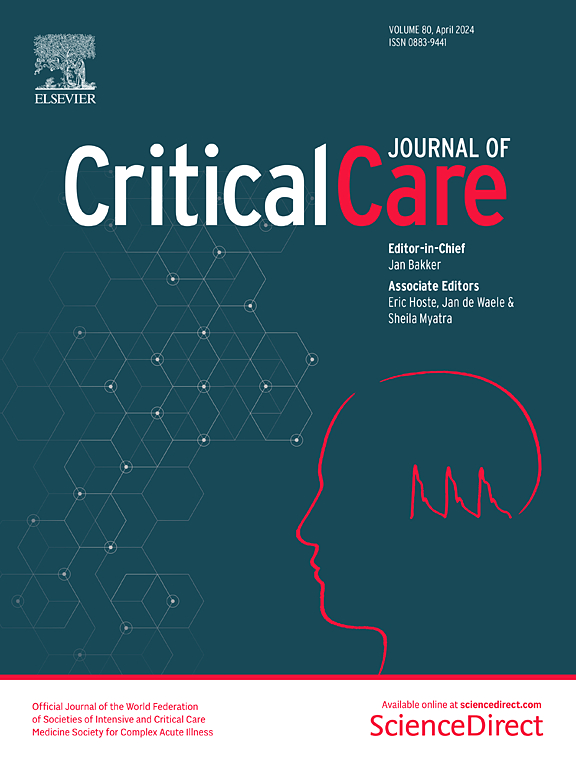Ventilation-induced acute kidney injury in acute respiratory failure: Do PEEP levels matter?
IF 8.8
1区 医学
Q1 CRITICAL CARE MEDICINE
引用次数: 0
Abstract
Acute Respiratory Distress Syndrome (ARDS) is a leading cause of morbidity and mortality among critically ill patients, and mechanical ventilation (MV) plays a critical role in its management. One of the key parameters of MV is the level of positive end-expiratory pressure (PEEP), which helps to maintain an adequate lung functional volume. However, the optimal level of PEEP remains controversial. The classical approach in clinical trials for identifying the optimal PEEP has been to compare “high” and “low” levels in a dichotomous manner. High PEEP can improve lung compliance and significantly enhance oxygenation but has been inconclusive in hard clinical outcomes such as mortality and duration of MV. This discrepancy could be related to the fact that inappropriately high or low PEEP levels may adversely affect other organs, such as the heart, brain, and kidneys, which could counteract its potential beneficial effects on the lung. Patients with ARDS often develop acute kidney injury, which is an independent marker of mortality. Three primary mechanisms have been proposed to explain lung-kidney crosstalk during MV: gas exchange abnormalities, such as hypoxemia and hypercapnia; remote biotrauma; and hemodynamic changes, including reduced venous return and cardiac output. As PEEP levels increase, lung volume expands to a variable extent depending on mechanical response. This dynamic underlies two potential mechanisms that could impair venous return, potentially leading to splanchnic and renal congestion. First, increasing PEEP may enhance lung aeration, particularly in highly recruitable lungs, where previously collapsed alveoli reopen, increasing lung volume and pleural pressure, leading to vena cava compression, which can contribute to systemic venous congestion and abdominal organ impairment function. Second, in lungs with low recruitability, PEEP elevation may induce minimal changes in lung volume while increasing airway pressure, resulting in alveolar overdistension, vascular compression, and increased pulmonary vascular resistance. Therefore, we propose that high PEEP settings can contribute to renal congestion, potentially impairing renal function. This review underscores the need for further rigorous research to validate these perspectives and explore strategies for optimizing PEEP settings while minimizing adverse renal effects.急性呼吸衰竭时通气引起的急性肾损伤:PEEP水平重要吗?
急性呼吸窘迫综合征(Acute Respiratory Distress Syndrome, ARDS)是危重症患者发病和死亡的主要原因,机械通气在其治疗中起着至关重要的作用。呼气末正压(PEEP)是MV的关键参数之一,它有助于维持足够的肺功能容积。然而,正压的最佳水平仍有争议。临床试验中确定最佳PEEP的经典方法是以二分法比较“高”和“低”水平。高PEEP可以改善肺顺应性并显著增强氧合,但在硬临床结果(如死亡率和MV持续时间)方面尚无定论。这种差异可能与以下事实有关:不适当的高或低PEEP水平可能对其他器官(如心脏、大脑和肾脏)产生不利影响,从而抵消其对肺的潜在有益作用。急性呼吸窘迫综合征患者常发生急性肾损伤,这是死亡率的一个独立标志。目前提出了三种主要机制来解释中压期间的肺肾串扰:气体交换异常,如低氧血症和高碳酸血症;远程biotrauma;血流动力学改变,包括静脉回流和心输出量减少。随着PEEP水平的增加,肺容量根据机械反应不同程度地扩大。这种动态是两种潜在机制的基础,可能损害静脉回流,可能导致内脏和肾脏充血。首先,增加PEEP可能会增加肺通气,特别是在高度可再生的肺中,先前塌陷的肺泡重新打开,肺体积和胸膜压力增加,导致腔静脉受压,这可能导致全身静脉充血和腹部器官功能受损。其次,在肺活量低的肺中,PEEP升高可能在增加气道压力的同时引起肺体积的微小变化,导致肺泡过度扩张,血管受压,肺血管阻力增加。因此,我们认为高PEEP设置可能导致肾充血,潜在地损害肾功能。本综述强调需要进一步严格的研究来验证这些观点,并探索优化PEEP设置的策略,同时最大限度地减少对肾脏的不良影响。
本文章由计算机程序翻译,如有差异,请以英文原文为准。
求助全文
约1分钟内获得全文
求助全文
来源期刊

Critical Care
医学-危重病医学
CiteScore
20.60
自引率
3.30%
发文量
348
审稿时长
1.5 months
期刊介绍:
Critical Care is an esteemed international medical journal that undergoes a rigorous peer-review process to maintain its high quality standards. Its primary objective is to enhance the healthcare services offered to critically ill patients. To achieve this, the journal focuses on gathering, exchanging, disseminating, and endorsing evidence-based information that is highly relevant to intensivists. By doing so, Critical Care seeks to provide a thorough and inclusive examination of the intensive care field.
 求助内容:
求助内容: 应助结果提醒方式:
应助结果提醒方式:


